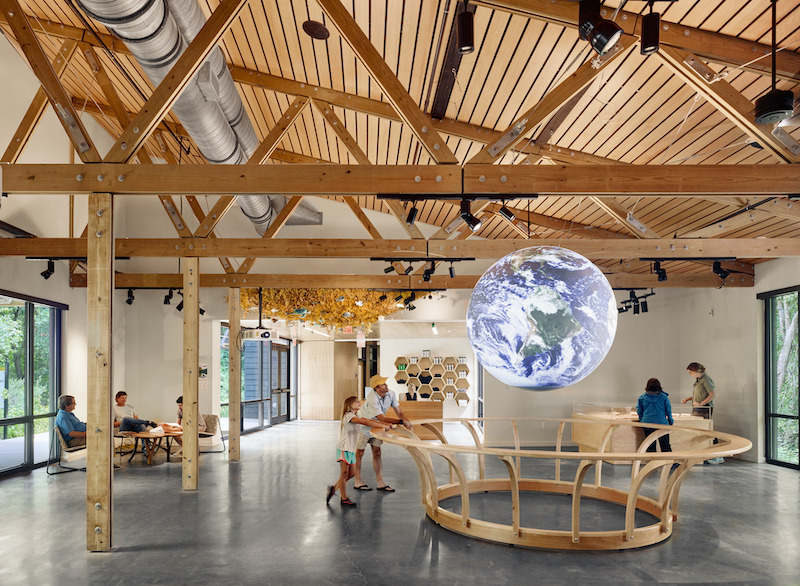The American Institute of Architects (AIA) Committee on the Environment (COTE) is announcing this year’s recipients for its highest honor, the COTE Top Ten Awards. Complete details for each project are available on AIA’s website.
COTE bestows the award annually on 10 design projects that have expertly integrated design excellence with cutting-edge performance in ten key areas. The COTE Top Ten winning projects illustrate the solutions architects provide for the health and welfare of our communities and planet.
In order to be eligible, project submissions are required to demonstrate alignment with COTE’s rigorous criteria, 10 measures that include social, economic, and ecological values. The five-member jury evaluates each project submission based on the effectiveness of their holistic design solution and metrics associated with the 10 measures. This year’s COTE Top Ten Awards recipients are as follows:
- Austin Central Library, Austin, Texas | Lake|Flato Architects + Shepley Bulfinch Joint Venture
- U.S. Land Port of Entry, Columbus, New Mexico | Richter Architects
- Etsy Headquarters, New York | Gensler
- Ford Foundation Center for Social Justice, New York | Gensler
- John W. Olver Design Building, Amherst, Massachusetts | Leers Weinzapfel Associates
- Keller Center - Harris School of Public Policy, Chicago | Farr Associates (Design Lead & Architect of Record) and Woodhouse Tinucci Architects (Collaborating Architect, Interior Designer)
- Marine Education Center at the Gulf Coast Research Laboratory, Ocean Springs, Mississippi | Lake|Flato Architects in association with Unabridged Architecture
- The Six, Los Angeles | Brooks + Scarpa
- UPCycle, Austin, Texas | Gensler
Jurors also designated one project as a Top Ten Plus recipient for its exceptional post-occupancy performance data. This year's recipient is:
- Environmental Nature Center and Preschool, Newport Beach, California | LPA, Inc.
Visit AIA’s website for more information on the COTE Top Ten Awards program.
In conjunction with COTE, the Association of Collegiate Schools of Architecture (ACSA) has selected the COTE Top Ten for Students, honoring exceptional student design projects showcasing innovation in sustainability. View the winning designs on ACSA’s website.
“The students being honored should be commended for their work and design intelligence. They provide great hope that future architects will have the skills and solutions to make our world better by integrating beautiful design with equitable climate action for human and ecological health,” said Julie Hiromoto, AIA, chair of COTE. “The COVID-19 pandemic has highlighted how necessary and valuable innovative design solutions are for healthy built environments.”
Since committing to environmental stewardship last year, architects have made notable progress in the climate action fight. Visit AIA’s website to learn more about all the climate action progress being made, including our first Climate Action Plan.
Related Stories
| Dec 29, 2014
14 great solutions for the commercial construction market
Ideas are cheap. Solutions are what count. The latest installment in BD+C's Great Solutions series presents 14 ways AEC professionals, entrepreneurs, and other clever folk have overcome what seemed to be insoluble problems—from how to make bricks out of agricultural waste, to a new way to keep hospitals running clean during construction.
| Dec 29, 2014
HealthSpot station merges personalized healthcare with videoconferencing [BD+C's 2014 Great Solutions Report]
The HealthSpot station is an 8x5-foot, ADA-compliant mobile kiosk that lets patients access a network of board-certified physicians through interactive videoconferencing and medical devices. It was named a 2014 Great Solution by the editors of Building Design+Construction.
| Dec 28, 2014
Robots, drones, and printed buildings: The promise of automated construction
Building Teams across the globe are employing advanced robotics to simplify what is inherently a complex, messy process—construction.
BIM and Information Technology | Dec 28, 2014
The Big Data revolution: How data-driven design is transforming project planning
There are literally hundreds of applications for deep analytics in planning and design projects, not to mention the many benefits for construction teams, building owners, and facility managers. We profile some early successful applications.
| Dec 28, 2014
AIA course: Enhancing interior comfort while improving overall building efficacy
Providing more comfortable conditions to building occupants has become a top priority in today’s interior designs. This course is worth 1.0 AIA LU/HSW.
| Dec 28, 2014
6 trends steering today's college residence halls
University students want more in a residence hall than just a place to sleep. They want a space that reflects their style of living and learning.
| Dec 28, 2014
Using energy modeling to increase project value [AIA course]
This course, worth 1.0 AIA LU/HSW, explores how to increase project value through energy modeling, as well as how to conduct quick payback and net present value studies to identify which energy strategies are most viable for the project.
| Dec 28, 2014
The lowdown on LODs: Bringing clarity to BIM
These days, BIM is par for the course across most facets of design. But a lot of the conversation surrounding BIM still lacks clarity due to ambiguous terminology, a lack of clear-cut guiding illustrations, and widely varying implementation, writes GS&P's John Scannell.
| Dec 28, 2014
The future of airport terminal design: destination status, five-star amenities, stress-free travel
Taking a cue from the hospitality industry, airport executives are seeking to make their facilities feel more like destinations, writes HOK's Richard Gammon.
| Dec 28, 2014
10 key design interventions for a healthier, happier, and more productive workplace
Numerous studies and mountains of evidence confirm what common sense has long suggested: healthy, happier workers are more productive, more likely to collaborate with colleagues, and more likely to innovate in ways that benefit the bottom line, writes Gensler's Kirsten Ritchie.

















